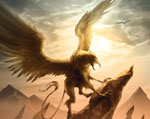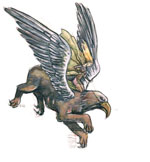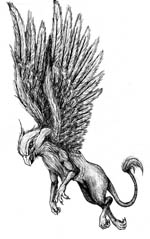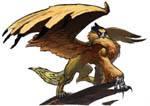
One of the more recognizable hybrid creatures today, the word Griffin comes from the Greek word gryphos meaning lion eagle. Sometimes known as the Gryphin, Griffon, Griffen, Gryph, Gryphus, Gryphon or Epimacus, this legendary creature was said to have the body of a lion and the head and wings of an eagle.
In the ancient world the lion was often considered to be the King of all Beasts, when combined with the eagle, often considered to be the King of the Air, it is no wonder that the Griffin was recognized throughout the world, particularly in ancient Greece, as a creature to be feared and respected. The Griffin was generally represented as having four legs, wings and the razor sharp beak of an eagle, along with equine like ears jutting from its head. Some traditions say that only female griffins have wings, and some writers described the tail as serpintine in nature.and the fore limbs as being the talons of an eagle rather than the paws of the lion.  The Griffin was sighted all over the ancient world, although many of the Northern European sightings can probably be attributed to the physiologically similar Opinicus, with which, it is said, the proud Griffin refused to breed. According to Pliny the Elder, the Griffins hailed from a region which is now located in Northern Russia. Aeschylus, an ancient Greek playwright, believed that these animals originated in Ethiopia and Thomas Bulfinch recorded in his three part work, known as Bulfinch's Mythology, that the Griffins were more than likely indigenous to India.
The Griffin was sighted all over the ancient world, although many of the Northern European sightings can probably be attributed to the physiologically similar Opinicus, with which, it is said, the proud Griffin refused to breed. According to Pliny the Elder, the Griffins hailed from a region which is now located in Northern Russia. Aeschylus, an ancient Greek playwright, believed that these animals originated in Ethiopia and Thomas Bulfinch recorded in his three part work, known as Bulfinch's Mythology, that the Griffins were more than likely indigenous to India.
Perhaps the most famous story regarding the Griffin involves the notorious historical figure; Alexander the Great. According to legend, Alexander captured a pair of Griffins and chained them to his throne. After cruelly starving the beasts for three days, Alexander began to taunt the creatures with large chunks of beef, which were impaled
upon lances and held just out of reach. The famous conqueror was able to tame one of the Griffins and used it to go on a flight around the country which reportedly lasted for seven days.
Tales of Griffin and the Arimaspi, a one eyed creature said to steal gold from the griffins, were elaborated in the lost archaic poem of Aristeas of Proconnesus, Arimaspea, and eagerly reported by Herodotus and in Pliny's Natural History. The Griffin was supposed to watch over gold mines and hidden treasures.. The Griffin is also said to be the enemy of the horse and the incredibly rare offspring of a griffin and a horse was called a hippogriff.  Griffins were consecrated to the Sun; and ancient painters represented the chariot of the Sun as drawn by griffins. The griffin was a common feature of animal style Scythian gold; it was said to inhabit the Scythia steppes, the area in Eurasia inhabited by the Scythians, from the 8th century BC to the 2nd century AD,which reached from the modern Ukraine to central Asia; there gold and precious stones were abundant; and when strangers approached to gather the stones, the creatures would leap on them and tear them to pieces. The Scythians used giant petrified bones found in this area as proof of the existence of Griffins and to keep outsiders away from the gold and precious stones. It has recently been suggested that these so called griffin bones were actually dinosaur fossils, which are common in that part of the world.
Griffins were consecrated to the Sun; and ancient painters represented the chariot of the Sun as drawn by griffins. The griffin was a common feature of animal style Scythian gold; it was said to inhabit the Scythia steppes, the area in Eurasia inhabited by the Scythians, from the 8th century BC to the 2nd century AD,which reached from the modern Ukraine to central Asia; there gold and precious stones were abundant; and when strangers approached to gather the stones, the creatures would leap on them and tear them to pieces. The Scythians used giant petrified bones found in this area as proof of the existence of Griffins and to keep outsiders away from the gold and precious stones. It has recently been suggested that these so called griffin bones were actually dinosaur fossils, which are common in that part of the world.
Adrienne Mayor, a classical folklorist, has made tentative connections, in Fossil Hunters: Paleontology in Greek and Roman Times, between the rich fossil beds around the Mediterranean and across the steppes to the Gobi Desert and the myths of griffins, centaurs and archaic giants which originated from the area. Mayor draws upon similarities that exist between skulls of the Protoceratops, a sheep-sized herbivorous dinosaur,, common to the area and the legends of the gold-hoarding griffin told by nomadic Scythians of the region.
In Ancient Egypt, the Griffin was depicted with a slender, feline body and the head of a falcon. Early statues depict them with wings that are horizontal and parallel along the back of the body. During the New Kingdom, depictions of Griffins included hunting scenes and several Divine figures in egyptian mythology where depicted as Griffins, including Sefer, Sefert, and Axex.
Ancient Elamites used a Griffin symbol extensively in their architecture. In Elamites legend, a Griffin was presented to the Elamite Gods. In Persian mythology, in particular during the Achaemenid dynasty, Griffins called Homa were used widely as statues and symbols in palaces. Homa also had a special place in Persian literature as guardians of light.  A 9th century Irish writer by the name of Stephen Scotus asserted that Griffins were highly monogamous, not only did they mate for life, but if one partner died, the other would continue throughout the rest of its life alone, never to search for a new mate. The Griffin was thus made an emblem of the Church's views on remarriage. Being in part both a flying and a land bound animal, it was seen in Christianity to be a symbol of Jesus Christ, who was both human and divine.
A 9th century Irish writer by the name of Stephen Scotus asserted that Griffins were highly monogamous, not only did they mate for life, but if one partner died, the other would continue throughout the rest of its life alone, never to search for a new mate. The Griffin was thus made an emblem of the Church's views on remarriage. Being in part both a flying and a land bound animal, it was seen in Christianity to be a symbol of Jesus Christ, who was both human and divine.
In the early Griffon Mythology, the Griffin was thought to build a next, like an eagles, but instead of laying eggs, would lay agates, a semi presious stone. Centuries later the Egg laying habits of the Griffin were described by St. Hildegard of Bingen, a German nun and author of the 12th century. She outlined how the expectant mother would search out a cave with a very narrow entrance but plenty of room inside, sheltered from the elements. Here she would lay her 3 eggs, about the size of Ostrich eggs, and stand guard over them.
In architectural decoration the griffin is usually represented as a four footed beast with wings and the head of a leopard or tiger with horns, or with the head and beak of an eagle. The griffin is the symbol of the Philadelphia Museum of Art and you can see bronze castings of them perched on each corner of the museum's roof, protecting its collection.  A Griffin, spelled gryphon in this instance, is featured in Lewis Carroll's Alice in Wonderland in which the Queen of Hearts' orders the gryphon to take Alice to see the Mock Turtle and hear its story. The original illustrations by Sir John Tenniel depict the gryphon in an unusually naturalistic style.
A Griffin, spelled gryphon in this instance, is featured in Lewis Carroll's Alice in Wonderland in which the Queen of Hearts' orders the gryphon to take Alice to see the Mock Turtle and hear its story. The original illustrations by Sir John Tenniel depict the gryphon in an unusually naturalistic style.
Both Persians and Assyrians were known to decorate their temples with images of the Griffin. Depictions of two Griffins drinking from a flaming cup were a common sight in Zoroastrian temples. Centuries later, when European Crusaders encountered these ancient images, they were astounded by how similar they were to those of the Holy Grail, and the Griffin was adopted as a symbol of divinity, paving its way for use in many forms of Heraldic art.
A heraldic griffin,or gryphon, has the hind parts, including legs and tail, of a lion, the upper parts, including feathered neck, wings, claws, and head with beak, of an eagle and also ears. It is the ears which distinguish the griffin's head from an eagle's head in heraldry, which is important because in some cases just the Griffin's head is used and with out these ears would be identical to the head of the eagle.
According to the Tractatus de armis of John de Bado Aureo, late fourteenth century, “A griffin borne in arms signifies that the first to bear it was a strong pugnacious man in whom were found two distinct natures and qualities, those of the eagle and the lion”. Since the lion and the eagle were both important charges in heraldry, it is perhaps not surprising that their hybrid, the griffin, was also a frequent choice.
The symbolism of the lion eagle combination was also the subject of a quotation attributed to Chassaneus by Alexander Nisbet in his System of Heraldry, 1722; p 343 of Vol I of the 1816 edn: "Gryphus significat sapientiam jungendam fortitudini, sed sapientiam debere praeire, fortitudinem sequi.". This translates as: “The griffin represents wisdom joined to fortitude, but wisdom should lead, and fortitude follow".
Heraldic Griffins are usually shown rearing up, facing left, and standing on one hind leg with the other leg and the claws raised: this posture is described in the Norman French language of heraldry as segreant, a word uniquely applied to Griffins, and which is the exact equivalent of the description of lions and other creatures in heraldry as rampant.
A heraldic Griffin was included as one of the ten Queen's Beasts sculpted for the coronation of Queen Elizabeth II in 1953, following the model of the King’s Beasts at Hampton Court, and this is now on display at Kew Gardens.
The City of London adopted what are usually described as Griffins as supporters for its coat of arms, and it marks its boundaries with statues of a single Griffin carrying the City coat of arms at each road leading into the City of London. However, the City of London Griffins are, in fact, heraldic dragons, with scaly bodies and wings, no feathers, and no eagle's beak.
Some large species of vultures are called gryphons, the scientific name for the Andean Condor is Vultur gryphus, Latin for Griffin Vulture.
Is it possible that all of this came about as a result of newly discovered dinosour bones and the over active imagination of early man? Or could it be that the might Griffin was a real, living breathing, creature that once roamed the lands comanding respect from those lucky enough to witness its greatness and live to tell the tale? The world may never know the actualy truth behind the Griffin, be we do not that if this creature ever did actualy exist, it most likely would have gone extinct long ago.
The Evidence
No physical evidence exists that suggest that the Griffin is or ever was a real creature, only through ancient artwork, legends and writings to do know of this mighty creature.
The Sightings
There have been no reported sightings of the Griffin in modern times.
The Stats – (Where applicable)
• Classification: Hybrid
• Size: That of a Lion
• Weight: That of a Lion
• Diet: Carnivores
• Location: Africa, the Middle East, India and Europe.
• Movement: Flight and Walking
• Environment: Reported to Guard Gold Mines and Hidden Treasure, also Thought to Live in Mountainous Regions.
|